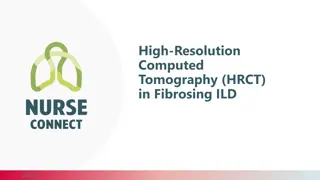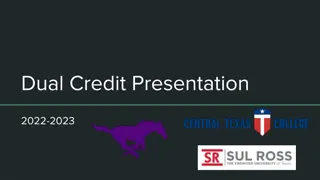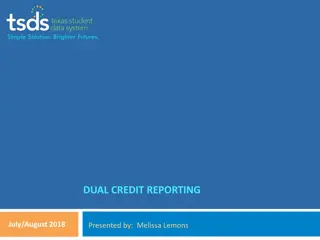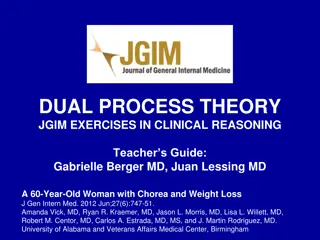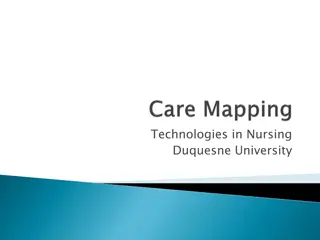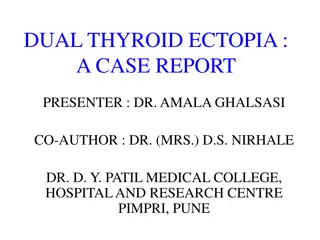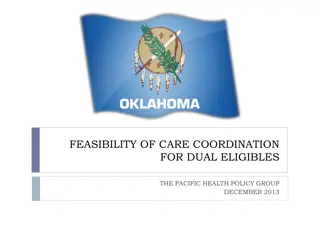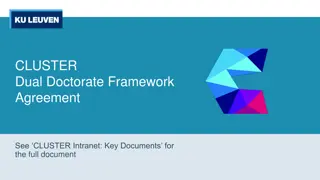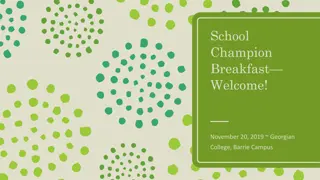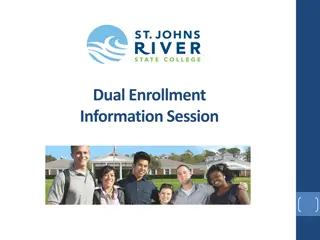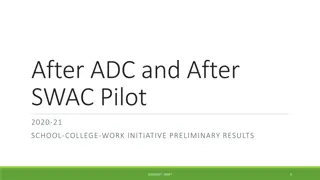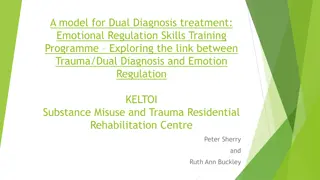
Dual Diagnosis in Intellectual Disabilities and Mental Health Disorders
Dual Diagnosis (DD) involves the co-existence of intellectual and developmental disabilities (I/DD) with mental health problems. Individuals with ID may also experience mental health disorders, requiring tailored community-based support and crisis intervention to enhance their well-being and inclusion.
Download Presentation

Please find below an Image/Link to download the presentation.
The content on the website is provided AS IS for your information and personal use only. It may not be sold, licensed, or shared on other websites without obtaining consent from the author. If you encounter any issues during the download, it is possible that the publisher has removed the file from their server.
You are allowed to download the files provided on this website for personal or commercial use, subject to the condition that they are used lawfully. All files are the property of their respective owners.
The content on the website is provided AS IS for your information and personal use only. It may not be sold, licensed, or shared on other websites without obtaining consent from the author.
E N D
Presentation Transcript
Dual Diagnosis I: Dual Diagnosis I: Intellectual Intellectual Disabilities and Disabilities and Mental Health Mental Health Disorders Disorders NDCPD NDCPD 895.53 895.53 JANUARY 2015 JANUARY 2015 Mary Beth Wilson, Regional Staff Trainer Life Skills and Transition Center July 2021 1
Dual Diagnosis (DD) refers to the co-existence of the symptoms of both intellectual and developmental disabilities (I/DD) and mental health problems. Mental Health Disorder (also called mental illness or a psychiatric disorder) is a mental or behavioral pattern that causes either suffering or an impaired ability to function in ordinary life. Mental Health refers to our emotional, psychological, and social well-being. It is all about how we think, feel, and behave. According to WHO (World Health Organization), mental health is a state of well-being in which an individual realizes his or her own abilities, can cope with the normal stresses of life, can work productively and fruitfully, and is able to make a contribution to his or her community. WHO emphasizes that mental health is not just the absence of a mental health disorder. / Behavior is observed actions such as walking, sleeping, and arguing. Actions you can see and describe. Maladaptive behavior is a behavior that is not in the person best interest. Dual Diagnosis (DD) 2
As many as 1/3 of those with an intellectual disability (ID) may also have mental illness Experience mental health disorders 2 to 4 times more often than the general population Ch 1: Ch 1: Introduction Introduction Prior to 1960, it was thought that a person s behavior was just due to the ID aspect; worry free, unable to express feelings (myths) Staff are the primary sources of information for professionals 3
Community-based model Provision for crisis intervention and preventative services, that are needed 24/7 for families and community agencies Goal is to fully support people in their communities', including the families Most current and most preferred service approach Requires all branches or parts of social service system work together using person centered approaches; focusing on abilities and desires of the person. Crisis prevention includes training and education for families and professionals 4
May have difficulty maintaining relationships with family and friends May be unable to get a job or stay employed If Left Generally, will not be a healthy , stable individual Untreated, the person . May bring undue attention to oneself, causing others to avoid him or her which will limit opportunities for inclusion Will be affected by further emotionally . . May have an impaired ability to feel successful and accepted by others May be unable to plan for their future, have goals and meet personal outcomes 5
People with diagnosis of both cannot function to their fullest if the mental illness is left untreated That means staff s job is critical! In order to do your job well: Get basic info about the people you work with Understand how people are diagnosed and how services are provided Understand the types of treatment used and what you should do Continue to improve your communication skills so information is accurate Realize how important you are 6
The Diagnostic Statistical Manual (DSM) is used in making a diagnosis. Guidelines are used by a psychologist, psychiatrist or physician. 19 broad categories of psychopathology (mental health disorders Ch 2: Mental Ch 2: Mental Heath Heath Professionals Professionals and Programs and Programs Provides general information about each diagnosis to help decide the category (very difficult to determine specific diagnosis) Problems that may occur with such a diagnosis Information on how many people have the diagnosis Usually happens to people with the diagnosis over a period of years 7
Diagnostic Overshadowing Health care professionals ignore mental health problems because the symptoms are judged to be just part of DD Over-attribute a person s symptoms to a particular condition. A mental health diagnosis is just ONE possible reasons for behavior that is not typical. Diagnostic team members may include: Psychiatrist Clinical social worker Licensed counselor Neurologist Mental health nurse practitioners School psychologist Diagnostic team is supported by: Exempt phycologists, phycology associates, school psychologists Behavior Analyst (BCBA) Direct support professional Support Coordinators (PC s, DDPM) YOUR ROLE IS AN IMPORTANT SOURCE OF INFORMATION. 8
1. Obtaining a history (social, psychological, past psychiatric history, family, and medical) 2. Evaluating the person s mental status (behavior, speech, emotions, cognitive, and perceptual processes) 3. Collecting auxiliary data (psychological and neurological) Psychiatric Assessment steps 4. Summarizing principle findings (summary of the major findings with a statement on immediate threat to life, such as suicide) 5. Rendering a diagnosis 6. Making a prognosis 7. Providing a bio-psychosocial formulation (psychiatrist s explanation and rationale for conclusions) 8. Determining a treatment plan 9
Mental Health Peer Support and Advocacy Groups (see module) Regional Human Services Centers (8) Regional Psychosocial Rehabilitation Centers Local Hospital Mental Health Centers North Dakota State Hospital Life Skills and Transition Center Counseling, mental health services, psychology, psychiatry Relationship building, improve quality of life through social- recreational opportunities., ensure continuum of care through referral and community resources Psychiatric centers within hospital providing short term stabilization services Evaluations and treatment for people who require longer stays than the local mental health centers; mental health and substance abuse treatment Services only when all other alternatives have been exhausted. CARES (Clinical Assistance, Resource and Evaluation Services) joint problem solving to support people continuing to live in their home; on site services and supports to stabilize and build skills to return home or to another community Local and Regional Service Providers 10
Adaptive vs. maladaptive Behaviors useful for independent life Behaviors that interfere w/ independence Ch 3: Ch 3: Understanding Understanding What We See What We See All behaviors have a purpose Our observation is key to discovering that purpose Assessment helps to make the best guess 11
Causes of Causes of Maladaptive Maladaptive Behavior Behavior Normal Reaction to Stress Result of medical issue Learned Learned because it is reinforced Other: diagnoses i.e. Prader-Willi Behavioral syndromes or shape behavior Psychosocial experiences 12
Diagnosing can be very difficult DSPs and team members must be good observers: The most important information is gathered by getting to know the person and understand their mode of communication Challenges to Challenges to DSPs/Teams DSPs/Teams Documenting what you see, is there an underlying health problem New adaptations for diagnosis of MI : People with IDD often do not have same characteristics of mental illness as others. Diagnostic equivalents in people with IDD may have to be researched. P. 25, 47, 48 13
Personality Disorders Involves personality traits, way a person thinks/behaves, way a person acts/reacts to other, qualities that make one person unique Form in infancy continue to death Disorders = begin early in life, occur over long periods, become part of their identity, impair life functioning Ch 4: Ch 4: Common Common Mental Mental Health Health Disorders Disorders 14
ID and Personality Disorders ID and Personality Disorders Depends on others, seeks approval, fear of strangers, can t problem solve, low self image, poor social skills presence of these characteristics does NOT mean there is mental illness tapping fingers, twirling hair, etc also need to be carefully evaluated before a diagnosis is made conditions of growing up may cause odd behavior, not necessarily MI 15
DSM DSM- -IV IV- -TR & Personality TR & Personality Disorders Disorders Cluster A odd or eccentric behavior Paranoid = interprets other s actions as threatening or demeaning Schizoid = a loner, very limited social relationships Schizotypal = very uncomfortable with close relationships, distorted thoughts & perceptions, eccentric appearance & behavior; oversensitive to criticism and anxious around people 16
Personality Disorders cont Personality Disorders cont Cluster B dramatic, emotional, erratic behavior Histrionic = shows emotions that don t fit the action going on Narcissistic = self absorbed does not take criticism well Antisocial = no respect for rights of others in trouble with the law often Borderline = instable mood, relationships, self image, impulsiveness (good then bad) 17
Personality Disorders cont. Personality Disorders cont. Cluster C anxious or fearful behavior Avoidant = overly sensitive always apologizing for fear of hurting someone s feelings Dependent = excessive need to be taken care of clingy pervasive Obsessive compulsive = orderliness, perfectionism, control - hard on anyone when things don t go their way 18
Remember Remember Characteristics in any of these categories must be a part of the person s identity not just an occasional occurrence Problems in at least one aspect of a person s life. Treatment: Therapy can be beneficial May include group psychological support Meds never a first choice 19
Suggestion for people who are anxious, fearful or dependent: 1. Support success. Provide as little or as much assistance for the person to be successful. 2. Believe the person is doing their best to cope. Interpret their behavior as needing rescue from their stress. 3. State how confident you are in their ability to respond well. 4. Tell the person exactly what they need to be doing to be successful Terry you need to use your schedule on your bulletin board to tell me what comes next. 5. Display confidence, calm, and stability. Do not look frustrated, angry, or distressed. 6. Make transitions (to the next activity, or environment) predictable. Use visual schedules, social stories, etc. 7. If the person falls apart help him/her orient to what is next. 20
Anxiety disorders Anxiety disorders Generalized Anxiety Disorder Anticipate and worry about future danger excessively. Phobias Extreme and unreasonable fear Both specific and social Obsessive compulsive (OCD) = obsessed with one particular task Post-traumatic Stress Disorder (PTSD) = re-experiencing a trauma that happened, avoids any connection to that incident IMPORTANT that staff become very good observes & recorders of possible triggers of fearful events Meds are temporary fix, therapy helps 21
Psychotic Disorders Psychotic Disorders Schizophrenia disturbance that lasts at least 6- month w/ 1 month of active symptoms (delusions, hallucinations, disorganized speech, disorganized or catatonic behavior) The most recognized characteristic is hallucinations which may also occur with delusions an delusions. Hallucinations may occur in stages Staff be observant of what to look for 22
Stages in Hallucinating Stages in Hallucinating Staff watch body language to show stage I. Comforting = nervous person comforted by staff being there or having quiet activities II. Condemning = more nervous, cannot pay attention, raising of heart rate, blood pressure, respiration, may be afraid, hallucinations more powerful III. Controlling = severe anxiety, voices become more controlling, poor attention, sweating begins IV. Conquering voices ordering & controlling hallucinations complex, may last for hours or days, suicidal thoughts, possible violent behavior 23
Hallucinations cont. Hallucinations cont. Hallucinations can be very tiring give person time to recover after episode. The goal is to keep from going to stage IV. If no intervention occurs, hallucinations last longer & more severe Brain is sending incorrect messages More important to know the cause of the behavior in someone with Dual Diagnosis in order to treat the problem 24
Be Observant!! Be Observant!! 25
Be Be trusting Be Be consistent Read Read body language be a listener Support Support During During Hallucinations Hallucinations Be Be a good detective Take Take good data Record Record info the person describes Don t leave Don t leave them alone Don t argue Don t argue a hallucination is real to the person having one 26
Mood Disorders Mood Disorders D depression (sadness) E energy (loss of) Diagnosis: At least 5 major symptoms In the same 2- week period Represent a change from previous functioning P pleasure (diminished interest) R retardation (psychomotor slowing or agitation) E eating (changes in weight or appetite) S suicide (recurrent thoughts of death) S sleep (insomnia or hypersomnia) I indecisive (poor concentration) N negative thinking (worthlessness, hopelessness) G guilt (inappropriate) 27
Mood Disorders cont. Mood Disorders cont. Dysthymia is similar to major depression but is less severe Feel down in the dumps most of the time Persists for many years in a continuous, nagging form Impression is that the person is a whiner and complainer Traits: Depressed mood Suicidal thoughts/attempts or vegetative symptoms Anxiety Insomnia and sleep disturbance Behavioral issues 28
Mood Disorders cont. Mood Disorders cont. Bipolar Mood Disorder (BMD) One or more manic episodes followed by one or more depressive episodes Manic episode Overly excited lots of energy Lack of judgement Depressive episode Assessment of BMD difficult Not same characteristics as general population. 29
Treatment: multifaceted Treatment may target: Biological, psychological, environmental factors 1. Strategies can be aimed at reducing the signs and symptoms of mood disorders (biophysical). Medication Diet Exercise 2. Strategies cam aimed at budling positive mental health habits and decreasing vulnerability to future episodes ( psychological or environmental). Psychotherapy Counseling Skill building Environmental modifications 3. As a DSP your daily interactions are critical to the treatment of mood disorders Adjust your expectations to be realistic and provide additional support when needed Do not take the person s behavior or statements personally Structure the environment and supports to keep the person safe Do not reinforce signs or symptoms, but don t argus or confront the person s delusions Examples of support strategies see p. 49 30
Attention-Deficit/Hyperactivity Disorder (ADHD) Features: short hyperactivity, short attention span, impulsivity Typically recognized during early elementary years May disappear in teen years or adulthood If ADHD is severe chances of persisting in adult hood is high. (50-60%) As an adult inattention, disorganization and failure to finish thing is seen 75% of adult have another condition ex: depression Treatment may include: Psychological treatment Cognitive behavioral therapy Medications Family counseling 31
Challenge for clinicians and service providers: accommodate the dual nature of IDD and mental health disorder requires specialized training Treatment focus on long term management and may include services from several different providers. Results in complexed case management. Ch 5: Services Ch 5: Services Individualized person-centered plans need: Assessment Baseline data: initial data which future data can be compared Multiple modes of treatment Advocacy Integration Ongoing quality assurance Collaboration among professional and service agencies 32
Team membership: write the plan and work together to support the person The person Direct Support Professionals (DSP) Psychiatrist Family Program Coordinator /Internal Case Manager Psychologist/Behavior Analyst Services: 33
o What problems have occurred because of the person s behavior? Description of the presenting problem: o Why has this referral been made? o What is happening? What may have caused the change? Did any physical or emotional event cause a change in the person or their environment? What is the person s present lifestyle (friends, where do they live, daily schedule, o How long has this been occurring? Background in the diagnosis of I/DD recreation, sleep and eating pattern)? What does life look like when they are doing well? Any abuse of alcohol or drugs? Any medical problems? Past mental health history? What has changed? The person once was ____ but now is____. Background information: 34
Treatment should include changing the environment, teaching new skills (replacement behaviors), prescribed medication and implementing positive behavior support plan (PBS or MPS plan). Regulations require that a data collect system to justify the use of medication. Active treatment (behavior support plan) must accompany any use of a psychotropic drug The team must attempt drug reduction along with the advice of a physician. Ch 6: Ch 6: Treatment Treatment The team must monitor side effects of the drug. Teams must know and define the targeted behaviors specifically. The best way to start the treatment program is to understand the diagnosis. The DSM-IV-TR can help you with that Sometimes there is a wide range of diagnoses for a single person known as diagnostic variability 35
Cognitive Behavioral Therapy Different therapies / used for different purposes: Dialectical Behavior Therapy used with people borderline personality disorder; helps to manage emotions and their responses Rational-Emotive Therapy - concerned with changing distortions people have; looks at the realities people have created in their language, beliefs, and philosophies. Motivational Interviewing collaborative, person centered form of guiding a person to prompt and strengthen motivation for change CBT- why might not work: Team doesn t know the person well enough Person does not have a reliable form of communication Person may not have life experiences that will help in communicating feeling, understanding relationships. The person may not understand how their behavior affects others. 36


